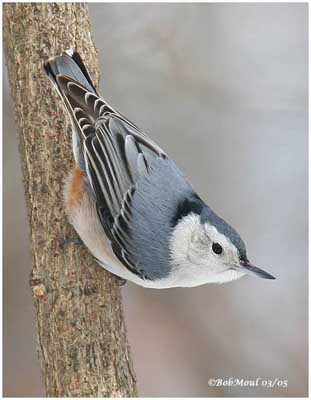
White-breasted Nuthatch
Sitta carolinensis
Passeriforme Order – Sittidae Family
BIOMETRICS:
Length: 13 à 14 cm
Wingspan : 20 à 27 cm
Weight : 18 à 30 g
LONGEVITY: Up to 10 years
DESCRIPTION:
White-breasted Nuthatch is a common bird frequently seen at bird-feeders and in gardens.

It has black cap and all white face and breast. Male has black cap extended to the neck, and forming a partial collar. Upperparts are blue grey. Wings and tail feathers present white edges. Tail is short.
Underparts are white, but we can see a rusty region on belly and towards the undertail coverts.
Bill is longer than those of other nuthatches, and seems slightly upturned. Eyes are black. The strong legs and feet are dark grey.
Female is similar, but duller and greyer than male, particularly on the head.
Juvenile resemble adults, but slightly paler.
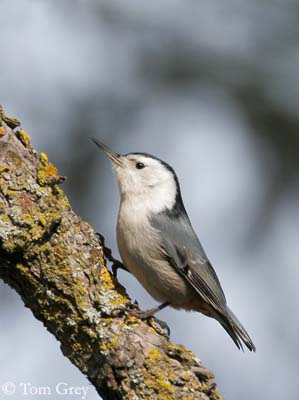
VOICE:
White-breasted Nuthatch’s call is a low, soft and nasal “yank” repeated. They sing several kinds of songs, consisting of several notes. These songs are used for territorial defence. We know 13 different calls, each call having a different purpose. Typical song is a rapid series of nasal whistles on one single pitch. They utter a sweet “chirp” when the mates meet, or when they feed their young.
HABITAT:
White-breasted Nuthatch is found in deciduous woodlands in the east, and in oaks and conifer forests in the west. It prefers openings and edges. We can also find it in parks and suburban areas with large trees.
RANGE:
White-breasted Nuthatch is resident in deciduous forests from Southern Canada, and southward to northern Florida and southern Mexico.
BEHAVIOUR:
White-breasted Nuthatch forages on trunks and branches, often head first. It places food in crevices of bark and hammers on it. It may hide some food in bark crevices for later use.
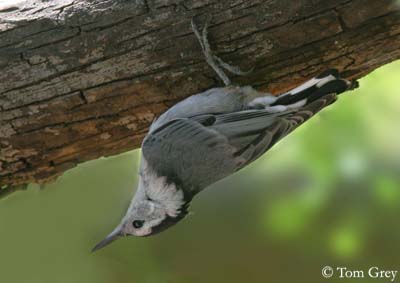
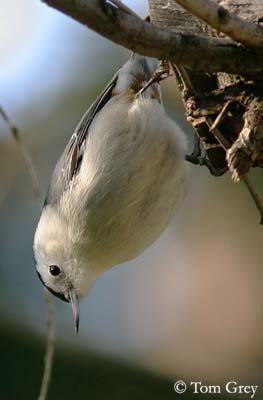
They climb up and down tree trunks. They search insects hidden in bark crevices along trunks and branches. It may feed on ground, hopping. They are diurnal birds.
White-breasted Nuthatch doesn’t migrate, and defends its territory year-round. It is dominated by the male, but both sexes live within this territory.
During winter, they may leave their territory to find food in other place, joining flocks of other small birds, and frequenting bird feeders.
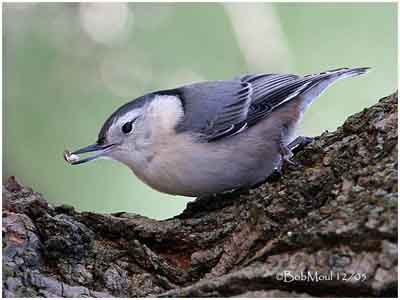
White-breasted Nuthatches are monogamous. Pairs remain together year-round, until one dies or disappears. Courtship display consists of breeding songs by the male, and courtship feeding. When a pair is engaged in excavating a hole, they congratulate each other. The male works in earnest, carrying off the bark chips chiselled by female. It may strut around her, peeping into the hole, or hover about her flying. And while she incubates the eggs, it feeds her and takes care of her.
White-breasted Nuthatches are fond of roosting in their own nest, using it year after year, cleaning or deepening it for the nesting period.
When a predator comes near the nest, White-breasted Nuthatch responds by pecking and flicking their wings, and uttering “hn-hn” noises. When parents leave the nest, they wipe around it with some piece of vegetation or hair, to avoid that predators find the nest with smell.
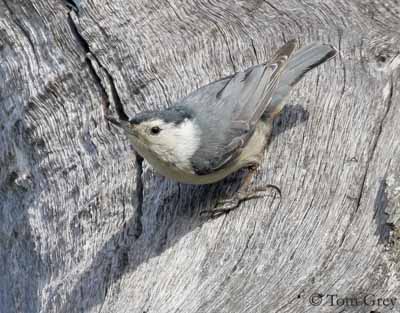
FLIGHT:
In flight, we can see white feathers on either sides of the tail. White-breasted Nuthatch has a rapid flight. To cross a river or a large area, it rises high, and flies with regular motion. But to pass from one tree to another, it flies forming a sweep.
REPRODUCTION:
White-breasted Nuthatch nests in holes, using natural cavity or an old woodpecker hole, and occasionally it may use nest-boxes.
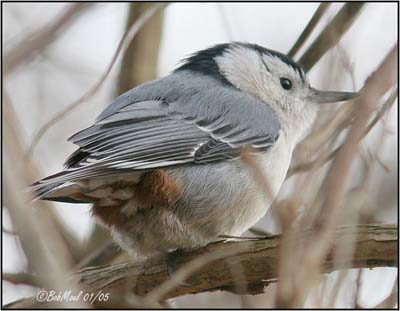
Nest is built by female. It is a soft cup made with bark fibres, grass, hair and feathers. She may add mud to the entrance, to protect from larger predators. Other manner consists of brushing the whole nest with a crushed insect, using perhaps chemical secretions to keep predators away.
Female lays 5 to 9 dull white eggs, spotted with brown on the larger end. Incubation lasts about 12 to 14 days, by female, fed by the male. Both parents feed the young. They leave the nest at about 14 to 26 days, remaining with adults for several weeks more, before to become independent. Parents teach them how to fly, to ascend the tree trunks, and to feed themselves. They reach their sexual maturity at one year.
This species produces one clutch per year.
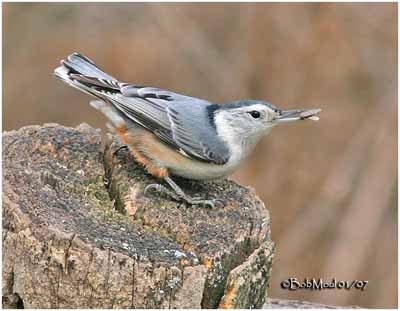
DIET:
White-breasted Nuthatch feeds mainly on insects and spiders. But it also eats vegetable food such as acorns, and other nuts or large seeds. During summer, it feeds only on insects.
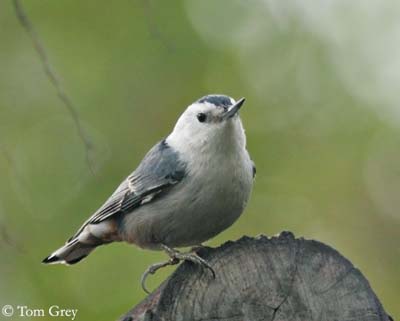
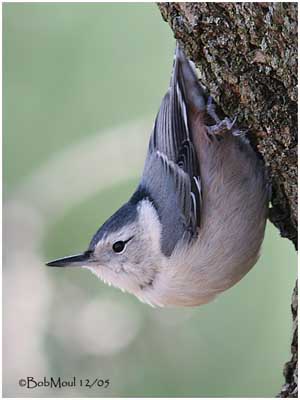
PROTECTION/THREATS/ STATUS:
White-breasted Nuthatch has some predators such as hawks and owls. Nestlings and eggs may be eaten by squirrels and snakes.
White-breasted Nuthatch is common and widespread, and populations are slowly increasing. Destruction and removal of dead trees may threat the quantities of cavity nesting.
Fr: Sittelle à poitrine blanche
All : Carolinakleiber
Esp : Sita de Pecho Blanco
Ital: Picchio muratore pettobianco
Nd: Witborst -boomklever
Sd: Vitbröstad nötväcka
Photographs by Bob Moul
His website:
Nature Photography
Photographs by Tom Grey
His website : Tom Grey's Bird Pictures
Text by Nicole Bouglouan
Sources :
HANDBOOK OF THE BIRDS OF THE WORLD Vol 13 by Josep del Hoyo-Andrew Elliot-Jordi Sargatal - Lynx Edicions – ISBN: 9788496553453
FIELD GUIDE TO THE BIRDS OF NORTH AMERICA - National Geographic Society - ISBN: 0792274512
THE HANDBOOK OF BIRD IDENTIFICATION FOR EUROPE AND THE WESTERN PALEARCTIC by Mark Beaman, Steve Madge - C.Helm - ISBN: 0713639601
All About Birds (Cornell Lab of Ornithology)
Animal Diversity Web (University of Michigan Museum of Zoology)
Bird Web (Seattle Audubon Society)
Wikipedia (Wikipedia, The Free Encyclopedia)
What Bird-The ultimate Bird Guide (Mitchell Waite)